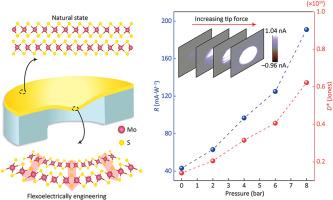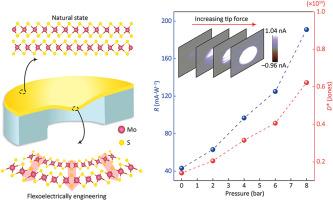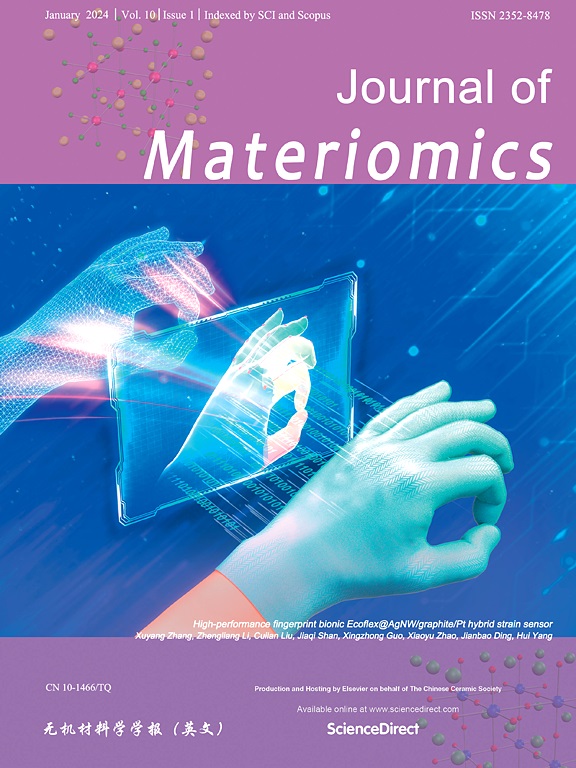Self-powered tunable photodetection via flexoelectric engineering of single-phase 2HMoS2
IF 9.6
1区 材料科学
Q1 CHEMISTRY, PHYSICAL
引用次数: 0
Abstract
Two-dimensional (2D) molybdenum disulfide (MoS2) has shown considerable potential for photodetection, yet existing MoS2-based photodetectors require either external voltage bias or complex heterojunctions. In this work, we present a new device concept based on flexoelectric engineering of bulk photovoltaic effect (BPVE) of 2H![]() MoS2, simplifying the device configuration considerably while enhancing its self-powered photodetection performance. By introducing a strain gradient in the suspended 2H
MoS2, simplifying the device configuration considerably while enhancing its self-powered photodetection performance. By introducing a strain gradient in the suspended 2H![]() MoS2, we break its inversion symmetry, resulting in BPVE in the otherwise centrosymmetric system. The significant flexoelectric polarization induced also facilitates efficient photocarrier separation, leading to a 41-fold enhancement in short-circuit photocurrent under a strain gradient of . Furthermore, the flexoelectric-engineered photodetector can be dynamically tuned via air pressure, enabling multilevel photoconductance and achieving a responsivity of 191 mA/W. This performance surpasses existing self-powered MoS2-based photodetectors reported in literature, offering a strategy for enhanced photodetection.
MoS2, we break its inversion symmetry, resulting in BPVE in the otherwise centrosymmetric system. The significant flexoelectric polarization induced also facilitates efficient photocarrier separation, leading to a 41-fold enhancement in short-circuit photocurrent under a strain gradient of . Furthermore, the flexoelectric-engineered photodetector can be dynamically tuned via air pressure, enabling multilevel photoconductance and achieving a responsivity of 191 mA/W. This performance surpasses existing self-powered MoS2-based photodetectors reported in literature, offering a strategy for enhanced photodetection.


基于柔性电工程的单相2H-MoS2自供电可调谐光探测
二维(2D)二硫化钼(MoS2)已经显示出相当大的光探测潜力,但现有的基于MoS2的光电探测器需要外部电压偏置或复杂的异质结。在这项工作中,我们提出了一种基于2H-MoS2体光伏效应(BPVE)柔性电工程的新器件概念,大大简化了器件结构,同时提高了其自供电光探测性能。通过在悬浮的2H-MoS2中引入应变梯度,我们打破了它的反转对称性,从而在原本中心对称的体系中产生了BPVE。显著的挠曲电极化诱导也促进了有效的光载流子分离,导致在应变梯度下短路光电流增强41倍。此外,柔性电工程光电探测器可以通过空气压力动态调谐,实现多级光电导,并实现191 mA/W的响应率。这种性能超越了文献中报道的现有的基于mos2的自供电光电探测器,为增强光探测提供了一种策略。
本文章由计算机程序翻译,如有差异,请以英文原文为准。
求助全文
约1分钟内获得全文
求助全文
来源期刊

Journal of Materiomics
Materials Science-Metals and Alloys
CiteScore
14.30
自引率
6.40%
发文量
331
审稿时长
37 days
期刊介绍:
The Journal of Materiomics is a peer-reviewed open-access journal that aims to serve as a forum for the continuous dissemination of research within the field of materials science. It particularly emphasizes systematic studies on the relationships between composition, processing, structure, property, and performance of advanced materials. The journal is supported by the Chinese Ceramic Society and is indexed in SCIE and Scopus. It is commonly referred to as J Materiomics.
 求助内容:
求助内容: 应助结果提醒方式:
应助结果提醒方式:


